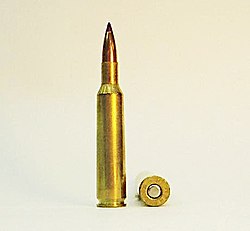6mm Remington
| 6mm Remington | ||||||||||||||||||||||||
|---|---|---|---|---|---|---|---|---|---|---|---|---|---|---|---|---|---|---|---|---|---|---|---|---|
 |
||||||||||||||||||||||||
| Type | Rifle | |||||||||||||||||||||||
| Place of origin | USA | |||||||||||||||||||||||
| Production history | ||||||||||||||||||||||||
| Designer | Fred Huntington & Mike Walker | |||||||||||||||||||||||
| Designed | 1955 | |||||||||||||||||||||||
| Manufacturer | Remington | |||||||||||||||||||||||
| Variants | .244 Remington | |||||||||||||||||||||||
| Specifications | ||||||||||||||||||||||||
| Parent case | 7×57mm Mauser | |||||||||||||||||||||||
| Case type | Rimless, bottleneck | |||||||||||||||||||||||
| Bullet diameter | .2435 in (6.18 mm) | |||||||||||||||||||||||
| Neck diameter | .276 in (7.0 mm) | |||||||||||||||||||||||
| Shoulder diameter | .429 in (10.9 mm) | |||||||||||||||||||||||
| Base diameter | .471 in (12.0 mm) | |||||||||||||||||||||||
| Rim diameter | .461 in (11.7 mm) | |||||||||||||||||||||||
| Case length | 2.233 in (56.7 mm) | |||||||||||||||||||||||
| Overall length | 2.825 in (71.8 mm) | |||||||||||||||||||||||
| Rifling twist | 1-9" | |||||||||||||||||||||||
| Primer type | Large rifle | |||||||||||||||||||||||
| Ballistic performance | ||||||||||||||||||||||||
|
||||||||||||||||||||||||
|
Test barrel length: 24" Source(s): Accurate Powder |
||||||||||||||||||||||||
The 6mm Remington rifle cartridge, originally introduced in 1955 by Remington Arms Company as the .244 Remington, is based on a necked down .257 Roberts cartridge using a .24/6mm bullet. Known for a combination of high velocity, long range, and accuracy, it is suitable as a dual use hunting cartridge for both varmints and medium-sized big game. When used in the less common earlier slow twist barrels, it offers exceptional range for varmint applications. While not as commercially popular today as it’s close cousin and competitor, the .243 Winchester, the 6mm Remington enjoys a slightly ballistic advantage and continues to be popular with handloaders and custom rifle builders.
By the early 1950s, there had been a significant amount of experimentation and 'wildcatting' in developing the .24 caliber bullet as a dual purpose hunting round. Popular cartridges necked down for this purpose included the .257 Roberts (based on the 7x57mm Mauser) and .308 Winchester.[2] Fred Huntington of RCBS had developed what was known as the .243 Rockchucker wildcat cartridge. This was a necked down .257 Roberts casing shooting a .24/6mm bullet. This ultimately became the .244 Remington. Mike Walker, who had previously designed the Remington Model 722, productized Huntington’s wildcat cartridge and adapted the Model 722 chambering for it which saw production in 1955.
The existing Remington Model 722 was chambered for the new .244 cartridge with a 1 in 12-inch twist. Remington originally offered this cartridge with 75 grain bullets for varmints and 90 grain bullets for medium-sized big game such as deer and antelope.[3][4][5]
...
Wikipedia
